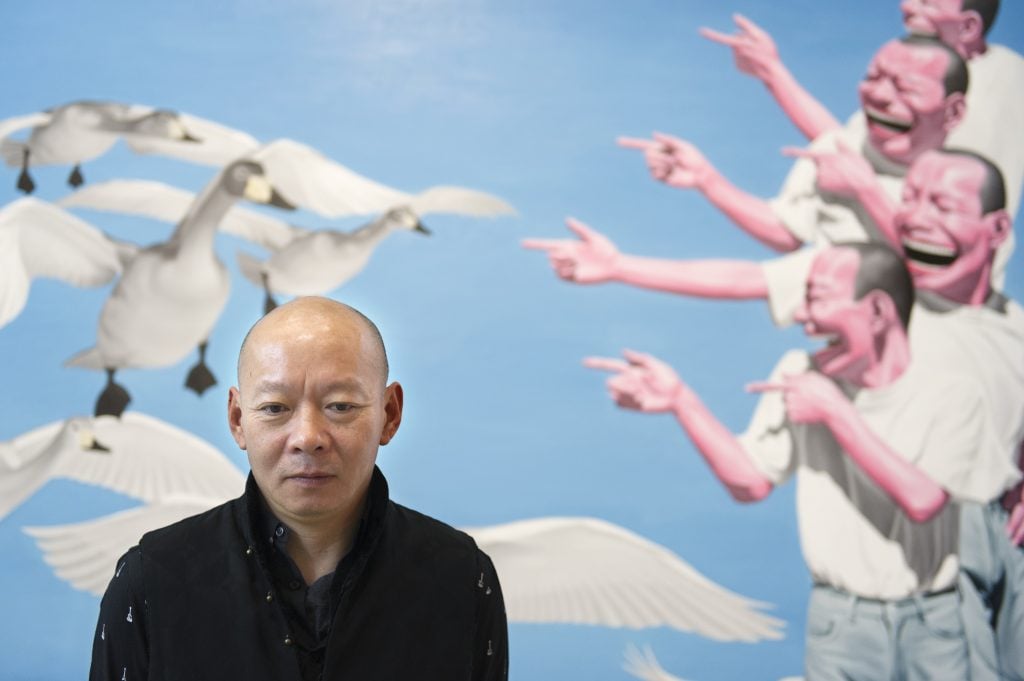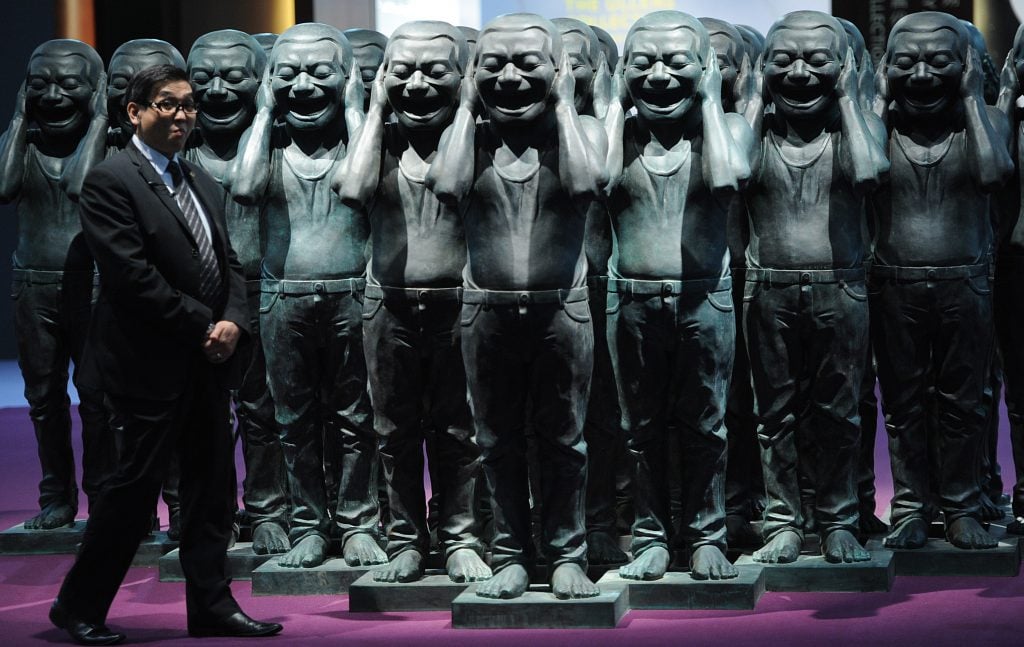Politics
Internet Netizens Accuse Renowned Chinese Artist Yue Minjun of Insulting the Country and Army with His Iconic ‘Laughing Man’ Paintings
The artist's longstanding series has captured the attention of nationalists online.

The artist's longstanding series has captured the attention of nationalists online.

Vivienne Chow

Renowned Chinese artist Yue Minjun has become the latest target among the nationalistic internet influencers and netizens in China, some of whom have accused him of insulting the country and tarnishing the image of the army with his iconic “laughing man” paintings.
Tweets and comments condemning the 61-year-old Beijing-based artist, one of China’s most prominent contemporary painters, began to emerge on social media platforms Weibo, WeChat, and Douyin (TikTok in China) this week after a local think tank named Kun Lun Ce Institute republished a 2021 essay on its official WeChat account that criticized the artist’s works for insulting the People’s Liberation Army (PLA), China’s military force. As of Friday, May 26, images of what believed to be Yue’s work related to the PLA appear to have been censored from Weibo, China’s equivalent to Twitter.
Recent attacks on Yue appear to be in line with a series of crackdowns and censorships of satire and comedy happening this month across China, including in Hong Kong, of voices deemed disrespectful to the authorities, particularly the PLA.
On May 17, comedy company Shanghai Xiaoguo Culture Media Co was fined 13.35 million yuan ($1.9 million) along with the confiscation of the 1.35 million yuan ($191,270) of “illegal gains” after one of its performances was accused of “harming society” with a joke about the military. Malaysian-born comedian Nigel Ng, who performs as the character Uncle Roger, was silenced this week on China’s social media after making jokes about the country in one of his recent performances. Also last week, the Hong Kong newspaper Ming Pao axed a comic strip column of top political cartoonist Wong Kei-kwan, who goes by his artist name Zunzi, after 40 years of publication.

A woman snaps a photo of art on display in front of an oil on canvas painting entitled Hats by artist Yue Minjun in 2006 at the Art Beijing 2006 exhibition at the National Agricultural Exhibition Hall in Beijing. Frederic J. Brown/AFP via Getty Images
As a key figure of the Cynical Realism movement spearheaded by artists who witnessed the turmoil of Cultural Revolution (1966-1976) that emerged in the 1990s after the 1989 Tiananmen crackdown, Yue’s depiction of eerie, exaggerated laughing faces is said to be self-portraits or his alter-ego. The works are widely seen as an iconic artistic expression and reflection of the country’s transformative era and its ascension as a global economic powerhouse.
Yue’s work has been widely exhibited across China and abroad over the past decades. His most recent solo show “Eudaimonia” at Tang Contemporary in Beijing, which closed on February 15, featured new works from this “Flower” series as well as works depicting the recurring laughing man motif. A review published on the Chinese website Artron praised the artist’s breakthrough in recent years with the creation of a new body of work, while continuing to reflect the human psyche amid the changing, unpredictable reality.
The resurfaced essay, however, targets Yue’s 2007 painting Armed Forces – Planche No. 17. The work depicts three laughing men who each don a hat representing the army, the navy, and the air force of the PLA respectively. The figures also have what appear to be devil’s horns on their heads peaking through the hats. (Both hats and devil horns are ongoing motifs in the artist’s work.)
Armed Forces – Planche No. 17 was pictured hanging in He Art Museum (HEM) as recently as 2021, a young private museum in Guangdong’s Shunde in southern China. Artnet News contacted the museum to ask if the work is still on the wall, but did not receive a response by publishing time. The republished essay accused the display of this work to be an “incident of an organized effort to insult the army and anti-Chinese Communist Party.” The text lists other Yue paintings deemed offensive to the army as well as former Chinese leaders.
The essay, re-uploaded on May 18, the day after the Shanghai comedy company was fined, spread like wildfire across China’s internet. One tweet on Weibo said that the paintings’ depiction of soldiers was exaggerated. “They give people an impression that they were done deliberately,” wrote the user in a post that has nearly 80,000 likes. Another tweet stated that paintings like Yue’s that target the country’s dignity appeal to the West and sell for high prices as a result.

A security guard walks past a work by Yue Minjun, entitled Contemporary Terracotta Warriors No 9, estimated at 1.8 – 2.3 million USD, at a Sotheby’s auction preview in Hong Kong on March 31, 2011. Sotheby’s Hong Kong will hold its 2011 spring sales this coming April. Mike Clarke/AFP via Getty Images
The controversy escalated yesterday when one user called for a blanket ban on the artist. One commented on Weibo saying that Yue should be banned from attending October’s Wuzhen Theatre Festival, where he has been named a member of the artistic committee.
Tang Contemporary, the gallery that represents Yue, declined to comment. Yue could not be reached for comment. Yesterday, the artist uploaded a picture of a painting of a fragmented laughing face embodied in a Buddhist sculpture on his Instagram.
Speaking about his art in a 2012 interview with the New York Times, Yue said that his paintings were not about laughing at anybody as they are mostly self-portraits. But he admitted then that his work was a question of reality, and “a smile doesn’t necessarily mean happiness; it could be something else,” he was quoted as saying by the New York Times. “And that laugh—anybody who’s gone through Chinese recent experience would understand it.”
Yue rose to international fame with the sale of his signature painting Execution (1995), which sold for a record £2.9 million ($5.97 million) at a Sotheby’s London auction in October 2007, as Chinese contemporary art became among the most sought-after art. He was listed as one of Time‘s Persons of the Year in 2007.
This record was smashed the following year with the sale of his 1993 canvas work Gweong-gweong at a Christie’s Hong Kong auction in May 2008, when the work sold for HK$54 million ($6.9 million), setting Yue’s auction record. Although the prices of Yue’s work at auctions have dropped in recent years as the market fever for Chinese contemporary art has cooled down, his works are still actively traded in the secondary market and widely exhibited.
More Trending Stories:
A Sculpture Depicting King Tut as a Black Man Is Sparking International Outrage